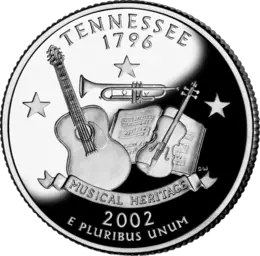 Tennessee is known for many great things — including the Smoky Mountains, hot chicken, and the Titans NFL team.
Tennessee is known for many great things — including the Smoky Mountains, hot chicken, and the Titans NFL team.
But when the United States Mint struck the Tennessee state quarter as part of their 50 state quarters program, it’s no surprise that Tennessee’s rich musical culture was the feature of the design chosen for the state’s quarter in 2002.
Following are some little-known facts about Tennessee quarters and how much they’re worth…
Tennessee State Quarter Design
As the 16th quarter in the series (which honors the 16th state admitted to the Union), the Tennessee State quarter celebrates 3 elements of the state’s musical heritage, as well as the 3 regions of Tennessee (east, west, and middle Tennessee).
The fiddle hearkens to the musical background of eastern Tennessee’s Appalachian region. The guitar brings to mind middle Tennessee’s rich Country music heritage.
The Jazz and Blues of west Tennessee are represented by the trumpet.
The 3 stars on the reverse symbolize the 3 distinct regions of Tennessee, as represented by the instruments.
Tennessee Quarter Values
Tennessee state quarters are worth between 50 cents and 75 cents in typical uncirculated condition, but only face value if worn.
Proof versions of the Tennessee State quarter are worth considerably more than face value.
Copper-nickel proofs can are valued at around $3 to $5 each, and 90% silver proofs are usually priced between $15 and $20 each.
Tennessee Quarter Errors
While there are currently no unique errors on the Tennessee quarter, some suggest the designs of the instruments on the coin are inaccurate.
For example, some say the guitar bears the wrong number of strings and the trumpet tubing is located in an incorrect place.
Check the coin out and see what you think.
Here’s a list of typical mint errors that you’re likely to find with Tennessee quarters as well.
Other Facts About Tennessee State Quarters
Nearly 1,000 design concepts were submitted to the Tennessee Coin Commission by June 1, 2000. The commission and Tennessee’s Governor, Don Sundquist, selected 3 finalist designs, which were then sent to the U.S. Mint. The 3 designs honored the the Women’s Suffrage movement, Sequoyah of the Cherokee nation, and Tennessee’s musical heritage (the eventual winner).
Governor Sundquist chose the “musical heritage” quarter from among 5 proposals the U.S. Mint sent him in the summer of 2001.
Issac Hayes, Ruby Wilson, Ricky Scaggs, Mint Director Henrietta Holsman Fore, Governor Sundquist, and Lakeview Elementary School teacher Shawn Stookey (the designer of the Tennessee quarter’s musical reverse) were among the many on hand for the official unveiling of the Tennessee state quarter at Nashville’s Country Music Hall of Fame on January 14, 2002.
Donna Weaver was the engraver of the Tennessee quarter. Weaver also engraved the Ohio, Indiana, and Mississippi quarters of 2002; the Illinois and Maine quarters of 2003; the 2004 Michigan quarter; the 2006 North Dakota quarter; and the Idaho quarter of 2007.




